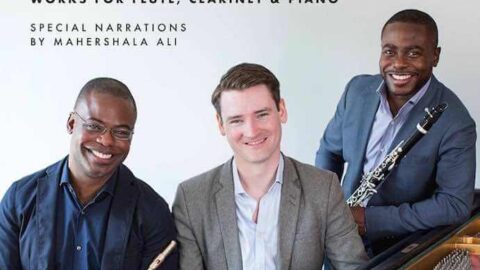In their CD debut released by Cedille Records, Portraits: Works for Flute, Clarinet & Piano, the McGill/McHale Trio sets out with a lofty and time-honored artistic tradition: to create a lasting impression of personal identity.
The naming of Portraits is more than just a quotation the CD’s central work, Portraits of Langston, by Valerie Coleman; Portraits reflects the McGill/McHale Trio’s personal philosophy for the album as a whole. The group is comprised of McGill brothers Demarre, flute, and Anthony, clarinet—historic figures in American classical music as two African Americans to first hold principle positions in several top orchestras. They are joined by the Irish pianist Michael McHale, and together the trio has produced a strongly autobiographical recording. In an interview with Cedille Records, Anthony McGill points out that “[Portraits] shows a lot of our characters, our personalities, our histories and our roots.”

As classical musicians are trained to execute and embody a composer’s intentions above all else, making a recording that embodies the player’s own personalities, histories, and roots is no easy or obvious task. However, the McGill McHale Trio is able to make many obvious identity connections through their repertoire choices, which range from old Irish folk tunes to commissioning a new work from Chris Rogerson (a Curtis alum, like both McGill brothers). Other connections are less self-evident but equally strong, like the pervasive use of various types of non-classical music. Take Paul Schoenfield’s Sonatina for Flute, Clarinet and Piano, which prominently features the Civil-War American folk song, “When Johnny Comes Marching Home Again” (also known as “The Ants Go Marching One By One”), or Coleman’s Portraits of Langston, which uses a gamut of styles with strong American roots, from jazz to swing to African spirituals.
On the subject of identity, what stands out most on this album is Coleman’s Portraits of Langston. Comprised of six vignettes inspired by a specific poem by Langston Hughes, Coleman prefaces each movement with a reading of Hughes’ corresponding poem, performed on this record by Mahershala Ali. By juxtaposing poem and song, Coleman makes connecting the music to Hughes’ evocative imagery easy; each movement has a clear character take-away, from the light, purity of “Helen Keller,” to the playful sparring of “Le grand duc mambo.”
At her best, Coleman utilizes specific techniques and timbres of each instrument to convey a particular and memorable image from Hughes’ poems in an unusual way: the low, slow oscillating clarinet sounds like the “low slow beating of the tom-toms,” or the jazzy piano that carelessly swings and improvises in response Hughes’ direction, “Play that thing,/Jazz band!” Coleman’s writing is often playful and fresh—the groovy back-and-forth between flute and clarinet in the “Le grand duc mambo” shows the absurdity of the brothel-brawl described in Hughes’ poem. In this series of specific and well-crafted vignettes, Portraits uncovers the vast range of characters and qualities that a flute-clarinet-piano trio can take on.

The rest of the album, while diverse in background, is less imaginative in comparison with Coleman’s work. While the fastidiously clean and often soulful playing of the McGill/McHale Trio stands out, the different works blend together in their similar timbral and harmonic ranges. There are many enjoyable moments, to be sure: the beginning of Rogerson’s River Songs, reminiscent of Copland, is wonderfully uplifting with its bright, repeated harmonies; Guillaume Connesson’s Techno Parade is a perfectly-executed technical whirlwind of rapid-fire notes in the clarinet and flute over a fun ostinato bass-line in the piano; Schoenfeld’s Sonatina is just hands-down a good time if you enjoy a swinging Charleston or a Ragtime that grooves. None of these works ask too much from the listeners; we hear new things and recognizable things, but our ears are not confronted with anything challenging or even unexpected. Nothing could be construed as too overwhelming, ugly, dissonant or disjointed; and it is the possibility of these things, the potential to subvert expectation, that often distinguishes the music we listen to over and over again from the music we don’t.
The final songs on the album, two Irish tunes, are in many ways as reflective and imaginative as Coleman’s and Hughes’ combined Portraits of Langston. The simplicity of these songs highlights the individual creativity of each of the players in the McGill/McHale Trio, and together they create a touching and intimate conclusion to their identity project.
























